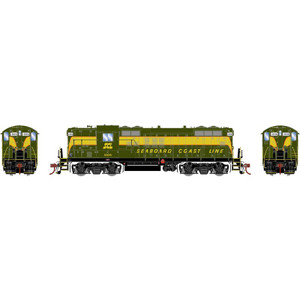SCL FEATURES:
- Extra grab irons on front
- Wind deflectors
- Cab roof vent
- Mixed wheel bearing caps per prototype
After the 1967 merger of ACL and SAL, a new paint scheme of black with yellow stripes was developed for the road’s diesels. However, repainting such a large roster of units would take time. As an interim measure, SCL lettering and/or logos were applied to many of the SAL-painted units to denote new ownership. This was known as the “split-image” scheme. This re-lettering operation included several examples of the road’s GP9 units, which are depicted here. They remained this way until repainted or retired.
ROAD NUMBER SPECIFIC FEATURES:
#1006- MARS-type headlights
- Nathan M-3 horn with all chimes forward
- Tall MU stands
- SCL logo on cab
- Leslie S-3K horn
- Short MU stands
- Early Pyle headlights
- Nathan M-3 horn with all chimes forward
- Short MU stands
- Early Pyle headlights
GP9 SERIES LOCOMOTIVE FEATURES:
- Full cab interior
- Wire grab irons
- Coupler cut levers
- See-through cab windows
- Flexible rubber trainline hose
- Flexible rubber MU hoses
- Drop steps unless noted
- “Nub” style walkway tread
- Lift rings
- Sander lines
- Windshield wipers
- MU stands
- See-through cab windows
- Bell placement & type per prototype
- Etched metal radiator intake grilles and fan grilles
- Air tanks mounted below sill unless noted
- Blomberg-B trucks with appropriate bearing caps
- Speed recorder unless noted
- Body-mounted McHenry® operating scale knuckle couplers
- DCC-ready features Quick Plug™ plug-and-play technology with 21-pin NEM connector
- Fine-scale Celcon handrails for scale appearance
- Detailed fuel tank with fuel fillers, fuel gauges, breather pipes, and retention tanks
- Genesis driveline with 5-pole skew wound motor, precision machined flywheels, and multi-link drivetrain
- All-wheel drive with precision gears for smooth & quiet operation
- All-wheel electrical pickup provides reliable current flow
- Wheels with RP25 contours operate on all popular brands of track
- Bidirectional constant LED lighting so headlight brightness remains constant
- Heavy die-cast frame for greater traction and more pulling power
- Scaled from prototype resources including drawings, field measurements, photographs, and more
- Accurately-painted and –printed paint schemes
- Fully-assembled and ready-to-run
- Packaging securely holds model for safe storage
- Minimum radius: 18” — Recommended radius: 22”
SOUND-EQUIPPED MODELS ALSO FEATURE
- Onboard DCC decoder with SoundTraxx Tsunami2 sound
- Dual cube speakers for optimal sound quality
- Sound units operate in both DC and DCC
- Full DCC functions available when operated in DCC mode
- Engine, horn, and bell sounds work in DC
- All functions NMRA compatible in DCC mode
- Precision slow speed control
- Program a multiple unit (MU) lashup with lead unit only horn, bell, and lights
- Many functions can be altered via Configuration Value (CV) changes
- CV chart included in the box
PROTOTYPE SPECIFIC INFORMATION
In 1949, EMD introduced the GP7. The basic design followed most diesel switchers with the addition of a short hood instead of an end-cab. The hoods were also full height to better accommodate the diesel engine and mechanical and electrical components.
In 1954 EMD upgraded the GP7 to become the 1,750 horsepower GP9. Externally, the first GP9s were virtually unchanged from the last GP7s. Later versions would include different louver arrangements and the last ones would come without the frame skirting. The GP9 was available with all of the fuel tank, steam generator, and dynamic brake options as the GP7, including “torpedo tube” air tanks mounted on the roof.
Many railroads chose to rebuild their GP7s and GP9s for continued service. Often times, it was cheaper to do this rather than purchasing brand-new locomotives.







